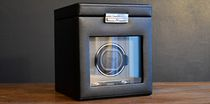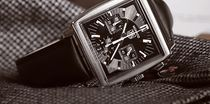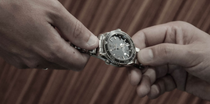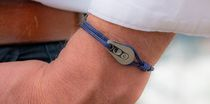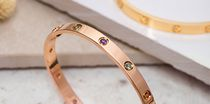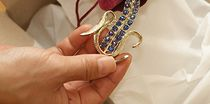A
Annual calendar
The annual calendar is a complication showing the date, day and month, and which automatically takes into account whether a month has either 30 or 31 days. With this complication, your watch needs to be set only one time a year, at the beginning of March..
Automatic
An automatic mechanical watch has a mechanism that is wound using energy provided naturally by movement of the wrist. The rotor, which winds the mainspring in the barrel, is moved by the force of our every movement. Find out more about your automatic watch.
B
Balance wheel
This circular, moving part of the movement vibrates on its rotational axis. It helps to prevent the movement from running fast or slow by vibrating regularly.
Barrel
The barrel is a cylindrical casing containing the mainspring. The barrel stores the power accumulated by the mainspring, which is later distributed to the gear train. In an automatic movement, the mainspring is wound by movement of the wrist whereas in a manual-winding movement, the mainspring is wound by turning the crown of the winding mechanism.
Bezel
The bezel is the ring around the watch face. It can be either fixed or rotating (unidirectional or bidirectional), and graduated to help measure a phenomenon and record data, such as a dive time.
Brushing
A type of polishing used on stainless steel and gold watches. The surface is "brushed" to give the parts a flat, lined finish.
C
Calibre
Originally a synonym for "size" when describing a watch movement, “calibre” now designates the movement itself. Followed by a series of numbers and letters, the calibre indicates the origin of the movement, its reference and the name of the manufacturer. Some brands manufacture their own calibre, called a "manufacturer's calibre". Nonetheless, many watches today are made using ETA calibres (mass-produced, very reliable generic movements).
Complication
There are many different watch complications. A complication is any function other than indicating the hours, minutes and seconds. The most common complications are the date, large date, chronograph, moon phase, second time zone, and power reserve. Grand complication watches can also have a minute repeater, a perpetual calendar, a tourbillon or many other functions.
COSC
The COSC, or Contrôle Officiel Suisse des Chronomètres, is an organization that grants the title of chronometer to the watches sent in for approval by watch manufacturers. Certification is given for each individual movement. Each movement undergoes a number of tests to verify its reliability and precision in different situations with variations in temperature. This certification is a true assurance of quality and craftsmanship.
Crown
The crown of the winding mechanism is a button that allows us to wind up a watch and set the hour, day and date. Some crowns, namely those on diving watches, are screw-down varieties in order to keep the watch waterproof. Sometimes, the winding mechanism crown is also a push-piece that triggers the chronograph
Cyclops
The Cyclops is a convex magnifying glass applied directly on the watch's crystal. It makes the date easier to read by magnifying it 2.5 times.
Chronograph
A chronograph is a watch that indicates the hour, minute and second and also has a complication that measures the duration of a phenomenon. This is done by activating a hand that can be stopped and reset to zero by simply pushing the dedicated buttons. The minute and hour meters on the dial add up the total number of times the chronograph hand has turned around the dial.
Chronometer
The chronometer is a high-precision watch that displays seconds and whose movement has been tested and certified by an independent organization, the COSC. A chronograph can be called a chronometer only if it has obtained certification by this official organization.
d
Deployment
A deployment clasp is a watchband fastening system that is jointed and unfolds when it opens. The deployment clasp can be single or dual and can be adapted to leather, stainless steel or gold watchbands. This clasp helps the watch to stay on the wrist if the clasp opens accidentally.
Dial
The main metallic part of the watch that displays all information (hour, minute and second) thanks to the hands and indices on it. Dials are found in a variety of wonderful colors, as well as in engraved or guilloche designs.
DLC
Diamond Like Carbon (DLC) is a coating that noticeably darkens the stainless steel of a watch. It is an alloy that combines carbon and diamond for maximum resistance. Thanks to ionization coating, a process used in Formula 1 racing and aerospace, this indestructible coating has been applied to watches.
f
Flute / fluted
Flutes are small grooves made along an arbor, stem or button so that it can be grasped firmly without our fingers slipping. We see these flutes on the crown of the winding mechanism, for instance. The term "fluted" refers specifically to the gold bezels on Rolex watches, which are sculpted with very elegant small bevels.
Flyback
The Flyback is a function originally designed for airplane pilots. This complication allows the watch's chronograph function to be stopped, reset and restarted with a single push of a button.
g
Geneva Seal
The Geneva Seal is a standard of excellence created in 1886 to promote and guarantee the quality of Geneva watchmaking. Today, it remains a reference in quality and a guarantee of know-how. To receive the famous stamp, a movement must meet several criteria regarding its place of manufacture, its craftsmanship and its reliability. As a result, the Geneva Stamp is often granted to exceptional models by top-name watch manufacturers whose movements were assembled, adjusted and cased in the Canton of Geneva.
Glidelock
The Glidelock system, patented by Rolex, was originally created to adjust the length of Rolex watches when worn on top of a diving suit. This highly practical innovation is found on the latest generations of Rolex Submariner watches and enables the watchband to be lengthened by up to 20 mm without the use of any tools.
GMT
In watchmaking, GMT (Greenwich Mean Time) is the name of a complication that simultaneously displays the time for two time zones. Originally created for the US Air Force, this function allows the wearer to set the time for the time zone they are in and that for the time zone of their home country. This is why timepieces equipped with this complication have always been associated with world travelers, such as pilots.
Gold (white, yellow, rose and red)
Gold is a noble material used extensively in jewelry and watches. The most common gold alloy is 18K. With a hardness of 3 on the Mohs scale, compared to 10 for the diamond and 6 for steel, gold is a highly malleable precious material. As a result, it requires great care. Yellow gold is an alloy composed of 75% pure gold, 12.5% silver and 12.5% copper. White or gray gold is an alloy made of 75% pure gold, silver and sometimes palladium. Rose gold is an alloy consisting of 75% pure gold, 20% copper and 5% sterling silver.
Guilloche
Guilloche is a decorative engraving technique, used on the watch's dial and certain other components, in which straight lines and curves cross or interlace. Guilloche can be done using a chisel or a lathe.
k
Karat
The karat is the unit for measuring the fineness of gold alloys. We are familiar with 9K, 14K, 18K and 22K gold, as well as 24K gold, the purest form of gold, also called "fine gold". The gold most often used for watch cases is an 18 karat (18K) alloy, which thus contains 18/24 or 750/1000 pure gold. When spelled as “carat” and abbreviated as "ct", the carat also denotes the international unit for the weight of precious and semiprecious stones. For more information, see the "carats" page in our jewelry glossary;
l
Luminova ®
Luminova® is a luminous substance applied to the hands, numerals or indices of a watch. It absorbs light and glows in the dark, making these parts highly visible. In the past, the substance that allowed parts to glow in the dark contained radium, a radioactive material. It was thus replaced by tritium, then by Luminova®, a registered trademark.
m
Manual (winding)
A manual-winding mechanical watch needs to be wound by hand. To wind the watch's mainspring, you turn the crown on the winding mechanism. For more information on the precautions to take when winding a watch, see our page dedicated to manual-winding mechanical watches.
Movement
All of the parts that come together to make a watch run. In a mechanical watch, the movement comprises the winding and time-setting mechanism, the gear train, the escapement and the balance spring. While the average watch movement has 130 parts, the world's most complicated movement, engineered by Patek Philippe, has 1,728
Moonphase
The moonphase is a complication that indicates the various moon phases. A lunar cycle lasts 29 days, 12 hours, 44 minutes and 28 seconds and is composed of 4 phases: new moon, first quarter half moon, full moon and last quarter half moon.
p
Perpetual
An old term for an automatic watch.
Perpetual calendar
The perpetual calendar is a complication showing the date, day, and month and which automatically takes into account whether a month has 28, 29, 30 or 31 days, whether it is a leap year or not. With this complication, the changeover from the end of the month to first of the month does not require you to reset the date on your watch.
Plate
The plate is a part of the movement that supports all of the mechanical components, including the dial. It has holes drilled in it at specific locations where various parts are screwed in
Platinum
Platinum, the most precious of metals, is rust-resistant and heavy. It is sometimes used to produce the cases of luxury watches.
Plexiglas
Crystals made of Plexiglas, a type of plastic, were used in the 1970s and 1980s. Today, they have been replaced by the sapphire crystal. Today, Plexiglas is found only on vintage watches or on re-editions of these watches, which thus retain the esthetic appeal of their elders.
Polishing
Operation performed by a watch specialist to give a stainless steel watch case or band its original look by eliminating all micro-scratches, with a flat or glossy finish. Gold watches are also polished.
Power reserve
This complication allows the amount of remaining energy stored in the watch to be displayed. The power reserve can be displayed on the watch dial in hours or days.
Push piece
The push piece is a button that, when pushed, triggers the chronograph.
PVD
Physical Vapor Deposition, or PVD, is a metallic coating process. This surface treatment is applied to the case and band of a stainless steel watch, resulting in a unique black finish.
q
Quartz
A quartz movement works thanks to a strip of quartz (a mineral) that transfers its vibration frequency to the watch circuit. This vibration is possible thanks to the energy provided by a battery and not by manual or automatic winding, as is the case with a mechanical watch.
r
Repeater
A repeater is a complication that indicates the time using an audible ring, upon request. There are several types of repeaters: quarter-hour repeaters, 5-minute repeaters and minute repeaters. When you push the push-piece, small hammers strike a gong, producing a very delicate sound. For example, with a minute repeater, the hours are indicated by a low note, the quarter hours by a low note followed by a high note and the minutes by a high note.
Repetition
The repeater is a complication that indicates the time by ringing, on demand. There are several types of repeater: the quarter and half-quarter repeater, the 5-minute repeater and the minute repeater. When the push-button is activated, small hammers ring on the gong and emit a very delicate sound. For example, with a minute repeater, the hours are indicated by a low note, the quarters by a low note followed by a high note, and the minutes by a high note.
Rotor
Syn. masse oscillante
Ruby
The rubies used in watch movements help to protect all of the pivoting axes from rubbing.
s
Sapphire (crystal)
The sapphire crystal is used for to protect the dials of most recent watches. Nearly scratchproof, it sometimes joins at the bottom of the case, allowing us to admire that watch's movement.
Stainless steel
Stainless steel, an alloy of iron and carbon, is a material commonly used in watchmaking. There are many different types of stainless steel, but the variety most commonly used in making watch cases is 316L stainless steel. Some brands, like Rolex, use a characteristic stainless steel, 904L, renowned namely for its corrosion resistance.
t
Tachymetric scale
The tachymetric scale is located on the flange of the dial or on the bevel of a watch. It is most commonly found on watches inspired by automobiles. It is used to help calculate the speed of a moving object over a given distance. Indeed, the information shown by the hand of the chronograph can be read on the tachymetric scale in order to determine its average speed.
Tang buckle
A tang buckle is a standard watchband fastening system, similar to a belt for the waist. The tang is the small piece of metal that is inserted into one of the holes on a leather watchband to block the buckle. Simple and precise!
Tourbillon
The tourbillon is a mechanical enhancement developed by Breguet to compensate for the effects of the Earth's gravity and thus make watch movements more precise. Indeed, the watch can gain or lose seconds depending on the position it is in. By mounting the balance wheel, the escapement and the pallet in a rotating cage, the effects of gravity are compensated for by eliminating any gaps that occur when the watch is in a vertical position.
Titanium
Titanium is a material frequently used in watchmaking, namely in the manufacturing of cases. It is loved for its corrosion resistance and light weight.
v
Vibration
The vibration per hour shows the frequency of oscillation of the balance wheel from one point to another. The balance wheel of a mechanical watch vibrates between 18,000 and 36,000 times (for the most precise movements, such as the El Primero) per hour.
w
Water-resistant
Water-resistant watches are fitted with specific water-resistance seals and a screw-down winding mechanism crown and back. Manufacturers provide water-resistance recommendations for each watch model, with levels of water resistance indicated in meters, ATM or bars. Certain watches do not withstand any contact with water whereas others are water-resistant down to 300 meters in depth. There are many variations between these two extremes. To find out more about how water-resistant your watch is, we recommend you check the Cresus water resistance table.
Winding
Winding up your watch enables you to get the watch up and running again after it has not been used for a while (for an automatic watch) or every day (manual-winding mechanical watch). Winding a watch involves manually or automatically creating tension in the mainspring so that it can accumulate energy to be later distributed in the movement.

